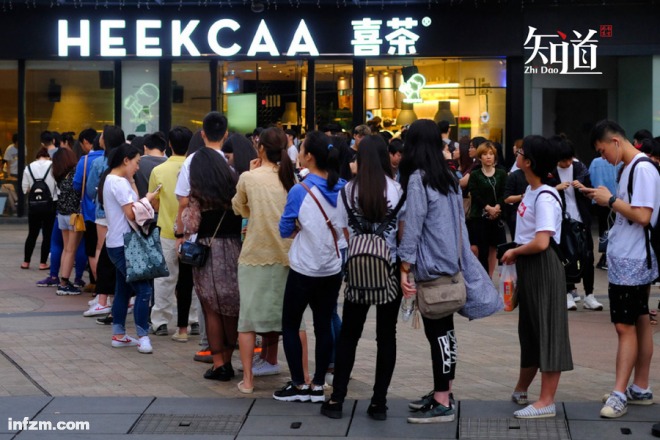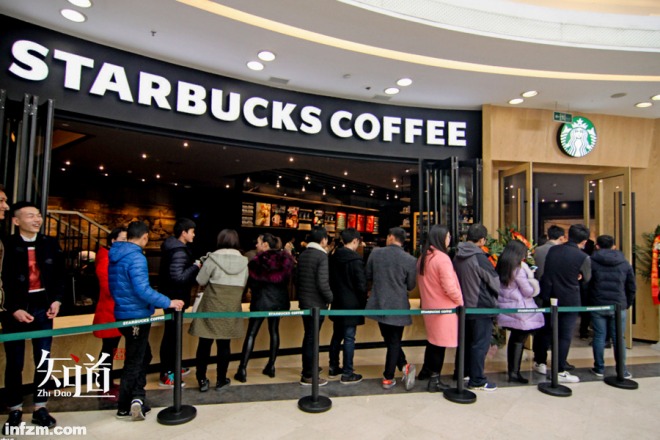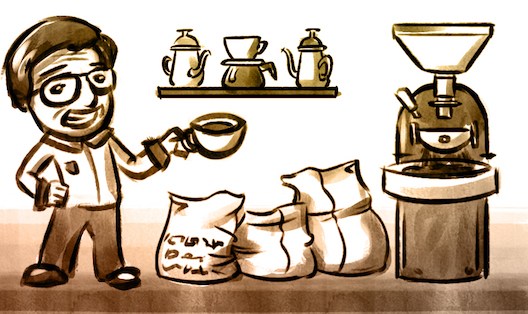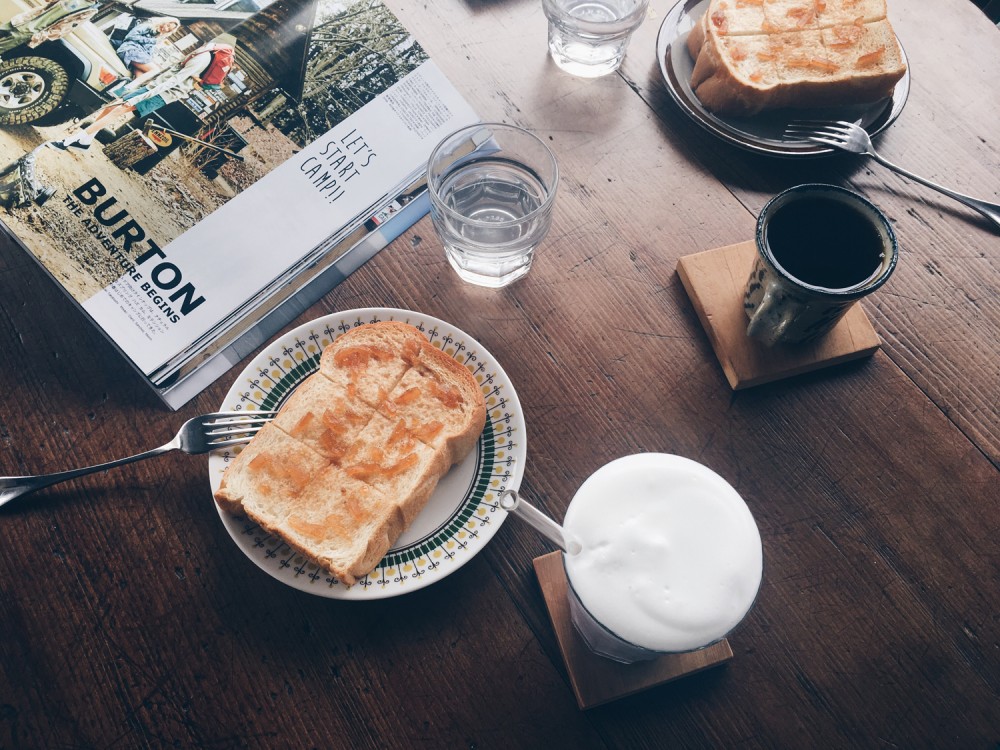Why are you ridiculed for buying tea and drinking Starbucks?
For professional baristas, please follow the coffee workshop (Wechat official account cafe_style)

Consumers queue in front of a tea shop in Guangzhou on April 15, 2017. (Oriental ic/ figure)
Some people can't help but feel aggrieved: people are obviously simply having a cup of coffee, enjoying cherry blossoms, or waiting in line to buy a cup of tea, which is not as complicated as you think. Such criticism is actually reasonable.
"nz_zhidao" to talk to you about why buying tea and drinking Starbucks are ridiculed?
On social media, the fate of anything that is touted and sought after is often ridiculed.
From the earliest time to drink Starbucks, many people's inner OS is that a cup of ordinary coffee is sold for a few dozen yuan, not for X. after that, eating okra, eating whole-wheat bread and enjoying cherry blossoms, which originally have a strong interest in middle-class life, are also ridiculed as a botched imitation. Then there is the happy tea and the flash funeral tea, is it true that this tea has any special taste, no, but there is a long queue outside the shop, and they all have petty bourgeois faces, eager to take wedding tea and funeral tea to take photos and post friends in a circle of friends.
This is indeed an interesting phenomenon. Whether they are followers or cynics, what kind of social psychology do they act out of?
The division of culture
The first thing we should see is that whether it is drinking Starbucks, watching cherry cherries in Japan, queuing up to buy happy tea, or looking for spiritual freedom in Xizang, these actions are relatively expensive, and they are not so popular. For example, everyone can afford an one-yuan cup of instant coffee, but it costs 30 yuan to go to Starbucks for a cup of coffee, and many people still feel distressed. As a result, these behaviors are relatively minority, and because of them, they show some kind of "coercion" in the public view-as if I did it, it looks different.
More crucially, these behaviors are attached to the imagination of the mass media about the middle class way of life. Although the definition of the middle class is vague in public opinion, in the discussion about the middle class, people are more likely to identify the middle class as a paradigm of life and way of consumption. "drive your own car and take your family out to play on a sunny holiday." Hoogewerf believes that this is the ideal life paradigm in the minds of Shanghainese, and to a certain extent, it is also in line with many people's imagination about the middle class life paradigm. As for consumption patterns, in the description of media and cultural products, the image of the middle class is becoming clearer and clearer: buying Nordic-style furniture at Ikea, tasting Starbucks coffee, using Japanese toilets and rice cookers, baking, eating okra and whole wheat bread, enjoying cherry blossoms, running marathons.
In 1979, Bourdieu published his masterpiece distinction: the Social critique of judgment, in which he said that any interest is not natural or pure, but the result of the interaction of habit, capital and field. In the process of growing up, a class needs to determine its identity through economic, political and cultural resources, and separate itself from other classes. Cultural division is a common practice of the middle class, who define their class boundaries through taste and middle-class taste. Drinking Starbucks, enjoying cherry trees and buying happy tea are just subtle manifestations of cultural division. the middle class achieve self-identity through these small actions, while the petty bourgeoisie complete their "middle-class dream" imagination through interesting learning.

Customers form a long queue outside Starbucks in Xiangyang City, Hubei Province, Feb. 5, 2016. (Oriental ic/ figure)
Sell ice to Eskimos
In 1999, Starbucks opened its first mainland store in Beijing ITC. But no one expected that Starbucks, a coffee chain that is no more common in the United States, has become a coffee aristocrat on Chinese land. In addition to Starbucks, there are also many sports shoes brands, car brands and cosmetics brands, whose domestic prices are much higher than those abroad, which is related to the popularity of foreign brands by domestic consumers, such as the middle class.
Famous photographer Wang Jiuliang once described China's consumer culture, "there is a slogan 'sell ice to Eskimos'. Maybe you don't need it at all, but he will always find a way to get you to buy it." Most of the time, we are spending for the sake of consumption, for the sake of face and vanity. " In other words, most of the time when we consume a certain brand, we are just consuming a certain symbol, and the premise is that we think this symbol has face. The Wall Street Journal said in a report that "when a Chinese can pronounce the foreign names of these brands confidently and naturally, it reflects a higher taste and gives it a certain degree of credibility in social circles."
When symbols are established, the consumption of symbols becomes an experience of a certain way of life. An article entitled "Chinese middle class does not pursue mid-range for American brands" once published on the website of BusinessWeek wrote, "the reason why many Chinese consumers go to Starbucks is to experience a certain way of life rather than a cup of coffee." Rein Xiaoshan explains Starbucks' success in China in his book the end of cheap China (The End of Cheap China). "people drink Starbucks coffee in order to experience the luxury life they have always dreamed of in their coffee cups. For many people, Starbucks coffee is actually a substitute for housing, cars and luxuries beyond their means. " That's why many young people in small towns are willing to spend months' wages on an iPhone.
However, the petty bourgeoisie and the middle class flocked to emulate and show off, on the contrary, some niche behavior has become a typical kitsch and deliberate show-off. Fans seem to be reminding others all the time: I just had a Starbucks. But maybe he doesn't like coffee, and he doesn't know the difference between Starbucks and instant coffee. He just wants to highlight the Starbucks brand and the imagination behind it. This kind of consumption is neither rational nor clever. On the contrary, it is laughed at by others because of its strong taste of pretending to be X.
The stigmatization of the middle class
Some people can't help but feel aggrieved: they simply have a cup of coffee, enjoy cherry blossoms, or wait in line to buy a cup of tea when they happen to be bored, which is not as complicated as you think. The client has no intention of pretending, it's just out of your envy and hatred, right? This is like saying that all the rich second generation are ignorant if they cannot afford to buy a luxury car or live in a luxury house.
Such criticism is actually reasonable. Any behavior, if it is only within the scope of ability, can please their own way of life, then it is worthy of respect, others have no right to say. However, in the context of public opinion, drinking Starbucks, buying happy tea and looking for freedom in Xizang all show a tendency of stigmatization-behind which is the stigmatization of the middle class.
I do not know since when, mocking the middle class has become a kind of "political correctness" of public opinion, food, clothing, housing and transportation have all become the target of criticism and ridicule by keyboard fighters. Curiosity Daily has a poll on "which foods reflect middle-class taste". The above options include the hard and bitter taste of kale, the cold-pressed juice of cold-pressed juice, the raw egg flavor of avocado, the stomachache of cold sandwiches, 99% of the bitterness of dark chocolate, and the hamburger steak made from black beans eaten by vegetarians. Netizens hit the nail on the head and mocked the menu with two words: bad. A popular article entitled "Spring outing, cherry appreciation and middle class anxiety" was also circulated everywhere in moments, which darkened the middle class's cherry appreciation behavior. After that, it also includes running, the middle class's attention to school district housing and children's education, and so on. In short, any thing or area that the middle class is concerned about will be ridiculed by good people.
Why is the middle class ridiculed? On the one hand, the middle class devote almost all their energy and enthusiasm to private life, and they do not have much enthusiasm for public affairs and public responsibility. on the contrary, they often show selfishness and haste to take more. This is indeed disappointing, and people can't help venting their discontent on complaints about the middle-class way of life.
On the other hand, it is also a kind of unhealthy social mentality. As the saying goes, "beggars will not envy millionaires who have become multimillionaires, but will only envy beggars who get more money than him." those who blindly laugh at the middle class are often those who want to become the middle class. More importantly, the reason why they unscrupulously ridicule the middle class is that in the atmosphere of public opinion, the middle class is the only soft persimmon that can be pinched, and other people may not dare to say it or cannot say it. Therefore, drinking Starbucks and buying happy tea are laughed at, but also very helpless. who is called the middle class whose name is also "weak"?
Important Notice :
前街咖啡 FrontStreet Coffee has moved to new addredd:
FrontStreet Coffee Address: 315,Donghua East Road,GuangZhou
Tel:020 38364473
- Prev

Shenwen | it's not coffee without future, it's specialty coffee with no future.
Professional barista communication please follow the coffee workshop (Wechat official account cafe_style) in 1993, when I went to the Muzhang International Food and Beverage equipment and Food Exhibition in Tokyo, Japan, I saw the development of Japan's own baking industry at that time. In the exhibition, Bonmac put forward the automation process and made a deep impression on my own baking (baking) concept store. When I returned to Taiwan, I bought it at Yonghan Bookstore.
- Next

[coffee Culture] Coffee Reading Shop-A coffee shop with good reading materials all over the wall
Exchange of professional baristas for cover photo_Terry Chang text _ Miki Wei; photo_ Miki Wei and Hope Chao follow the coffee workshop (official Wechat account cafe_style). "tell me what you like, and I'll know what kind of person you are," said Suvaran, a famous 19th century politician and gourmet. If you change it to: "tell me which cafes you go to."
Related
- How did the Salvadoran coffee industry develop in Central America?
- What exactly does the golden cup extraction of coffee mean?
- The Origin of Coffee flower
- [2023 Starbucks World Earth Day] there are more meaningful things besides free Starbucks coffee!
- What kind of coffee is there in Spain? 9 Flavors of Spanish Coffee
- Aromatic African coffee| Kenya's coffee culture and historical production area
- Liberica Coffee Bean knowledge: the characteristics of Liberian Coffee beans of the three original species of Coffee beans
- The origin and formula of Spanish latte introduces the taste characteristics of Bombon coffee in Valencia, Spain.
- How to adjust the solution of over-extracted coffee
- What is the tasting period of coffee beans? What is the period of coffee and beans? How should coffee wake up and raise beans?

